Thermal Performance Evaluation of Two Thermal Energy Storage Tank Design Concepts for Use with a Solid Particle Receiver-Based Solar Power Tower
Abstract
:1. Introduction
2. Overview of the Falling Particle Receiver Based Concentrated Solar Power Concept
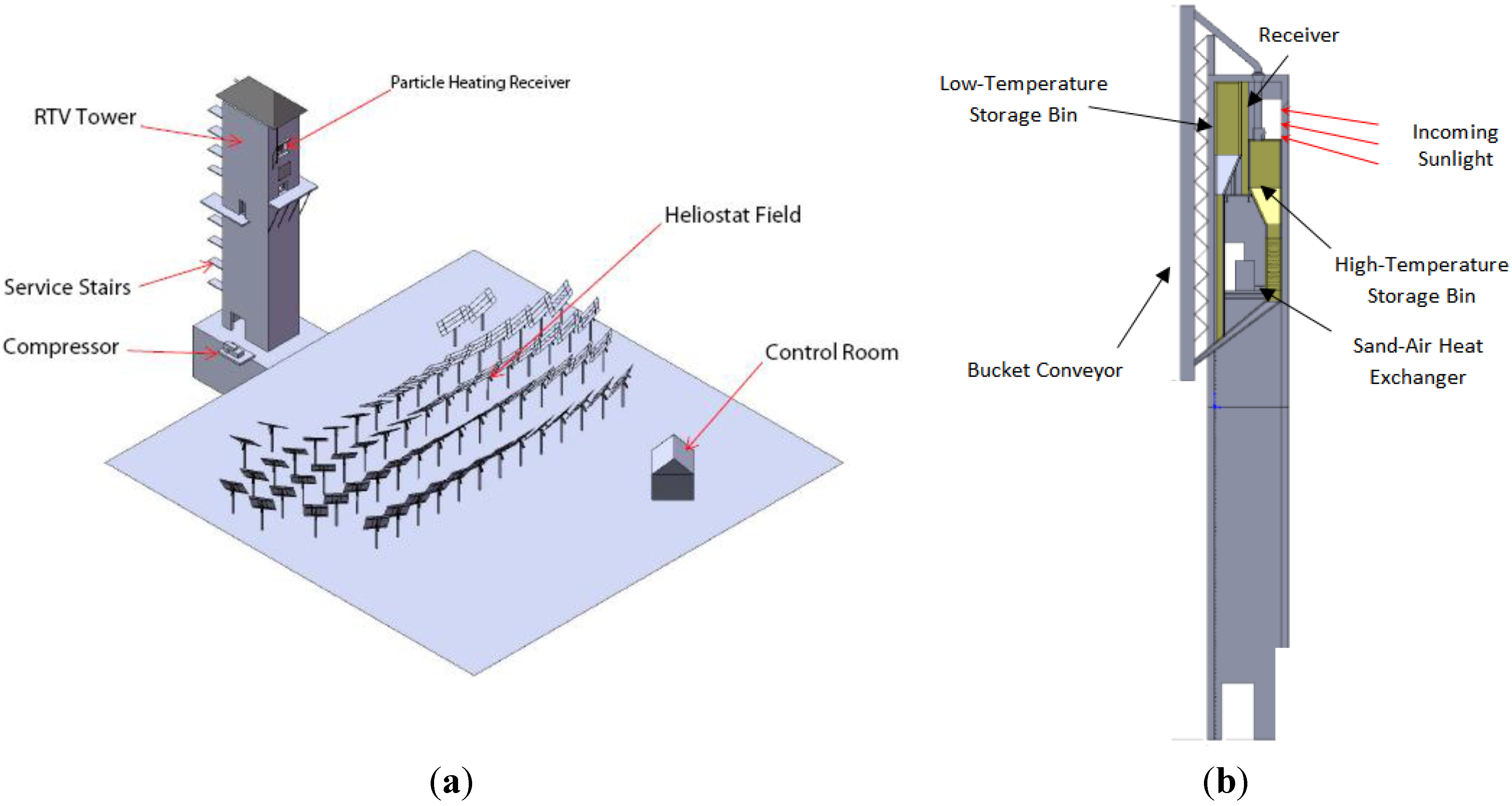
3. Material Selection for the Hot Bin
| Concept# | Design description | Assessment |
|---|---|---|
| 1 | Steel or metal frame | Not suitable—Does not meet the high-temperature requirements |
| 2 | Exotic metal frame | Not suitable—Does not meet the cost targets |
| 3 | Layers of FB + reinforced CB | Not suitable—Not expected to meet the heat loss limit |
| 4 | Layers of IFB + reinforced CB | Not suitable—Strength is questionable; does not meet the cost targets |
| 5 | Layers of FB + Perlite Concrete PC + reinforced CB | Warrants further investigation |
| 6 | Layers of IFB + Perlite Concrete PC + reinforced CB | Warrants further investigation |
| S# | Material | Thermal conductivity (W/m·K) |
|---|---|---|
| 1 | IFB | 0.17–0.2 |
| 2 | Autoclaved Aerated Concrete (AAC) | 0.11–0.15 |
| 3 | PC | 0.1–0.14 |
| 4 | Perlite Refractory Concrete (PRC) | 0.09–0.12 |
| 5 | Expansion Joint (EJ) | 0.038–0.05 |
4. First Scale Hot-Bin
4.1. Construction
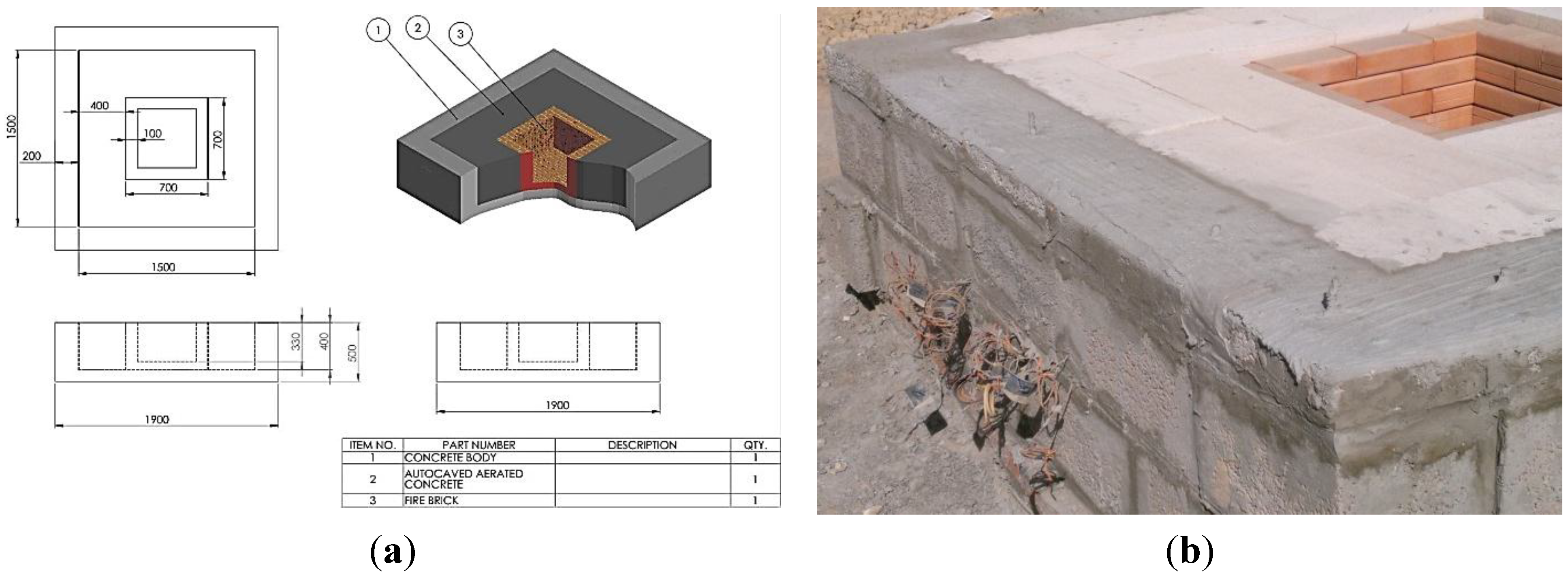
4.2. Computational Analysis
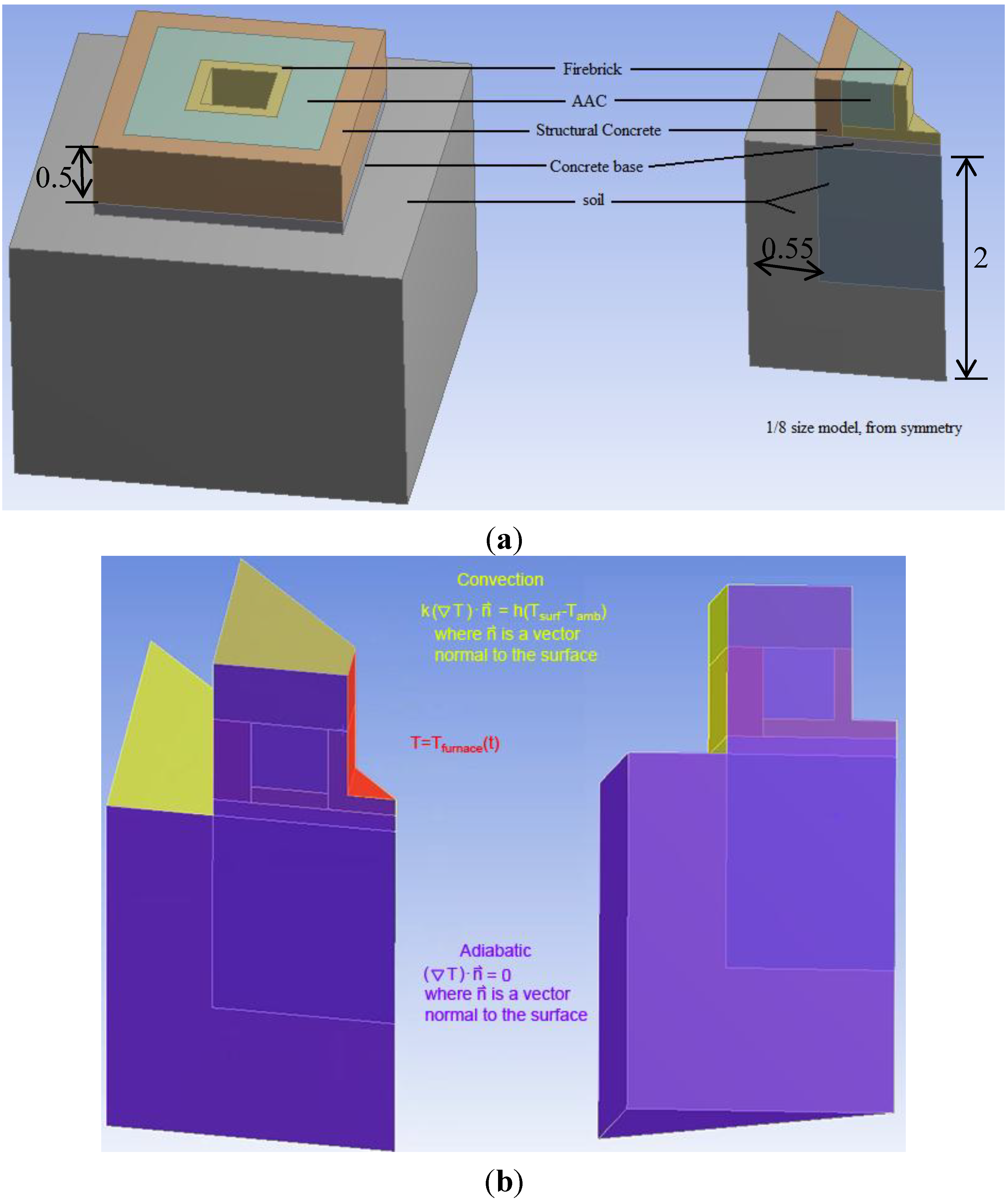

| S# | Temperature (°C) | Thermal conductivity (W/m·K) |
|---|---|---|
| 1 | 190.66 | 0.131 |
| 2 | 266.22 | 0.142 |
| 3 | 316.43 | 0.147 |
| 4 | 350.86 | 0.154 |
| 5 | 418.13 | 0.157 |
| 6 | 434.74 | 0.162 |
| 7 | 568.63 | 0.177 |
| 8 | 573.03 | 0.180 |
| 9 | 753.88 | 0.203 |
4.3. Results and Discussion
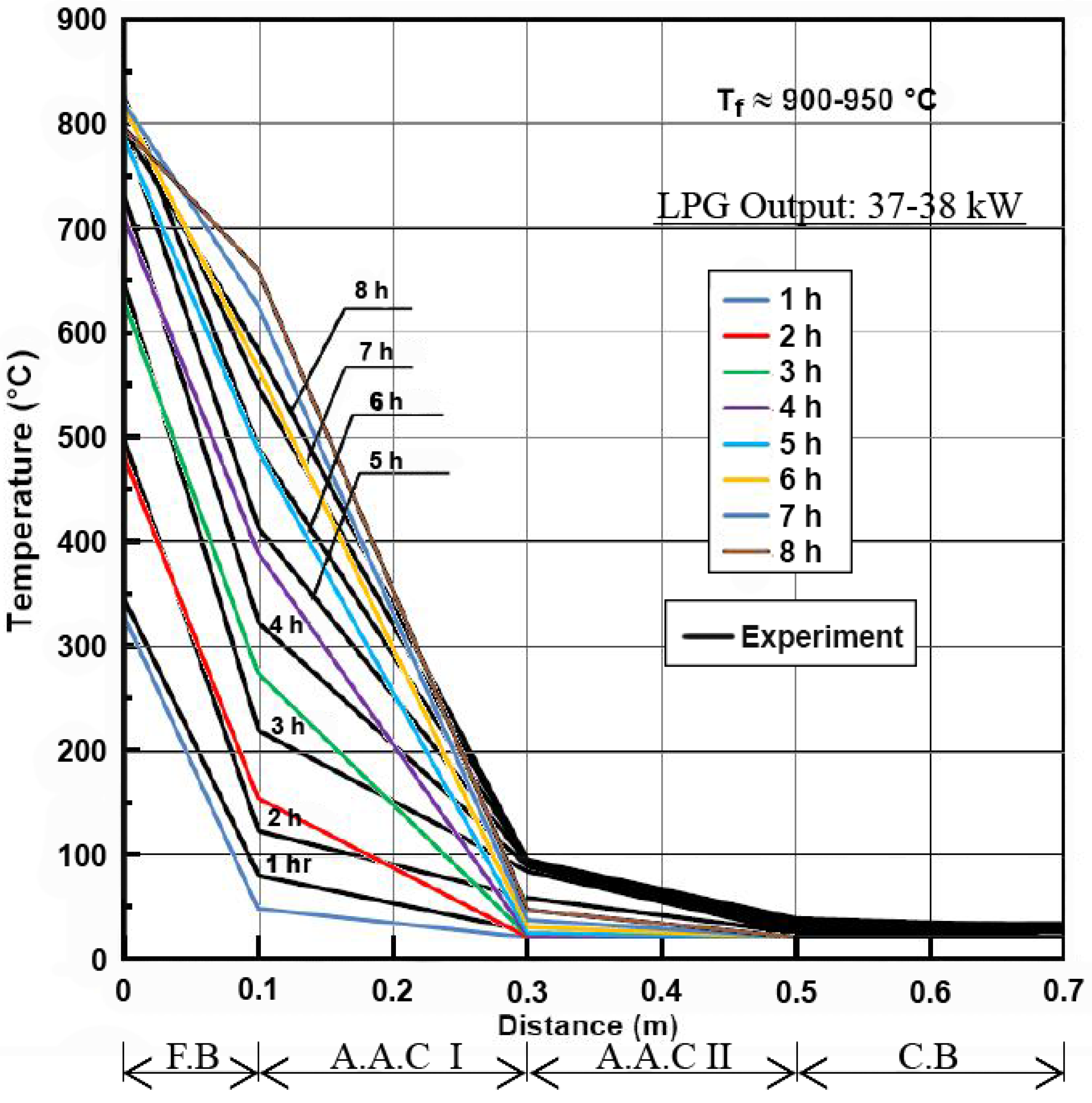
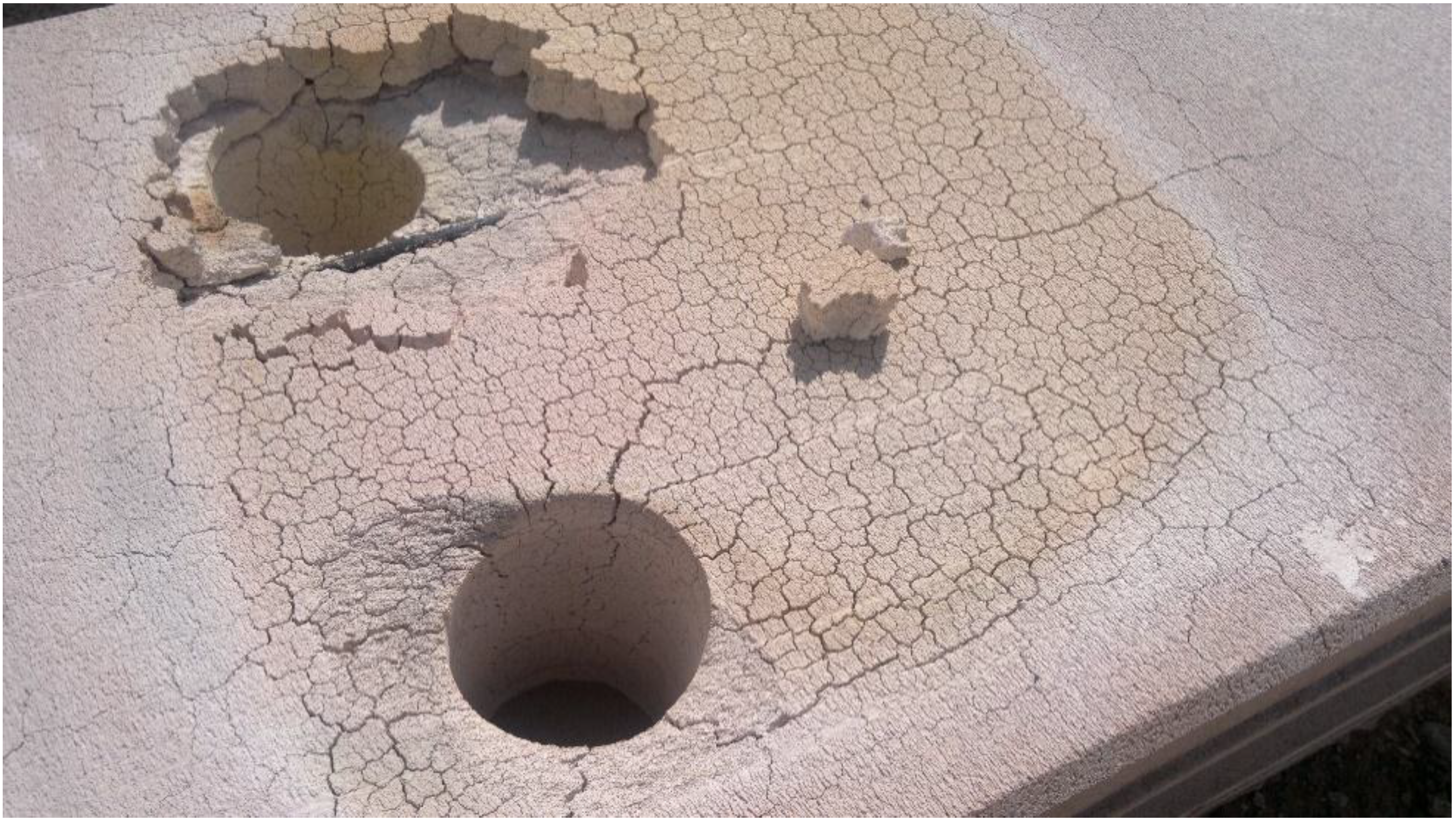
5. Improved and Refined Scale Hot Bin
5.1. Construction
- A test apparatus with a larger, more representative size was required to simulate the heat loss from the actual hot TES bin to be constructed within the 300 kW test facility at King Saud University (Riyadh, Kingdom of Saudi Arabia).
- Despite the durability and low cost of firebrick, its thermal performance was not suitable due to its high thermal conductivity.
- AAC is not suitable for use in future designs, due to the issue of cracking caused by high temperatures.
- It was necessary to regulate the flow of LPG more tightly.
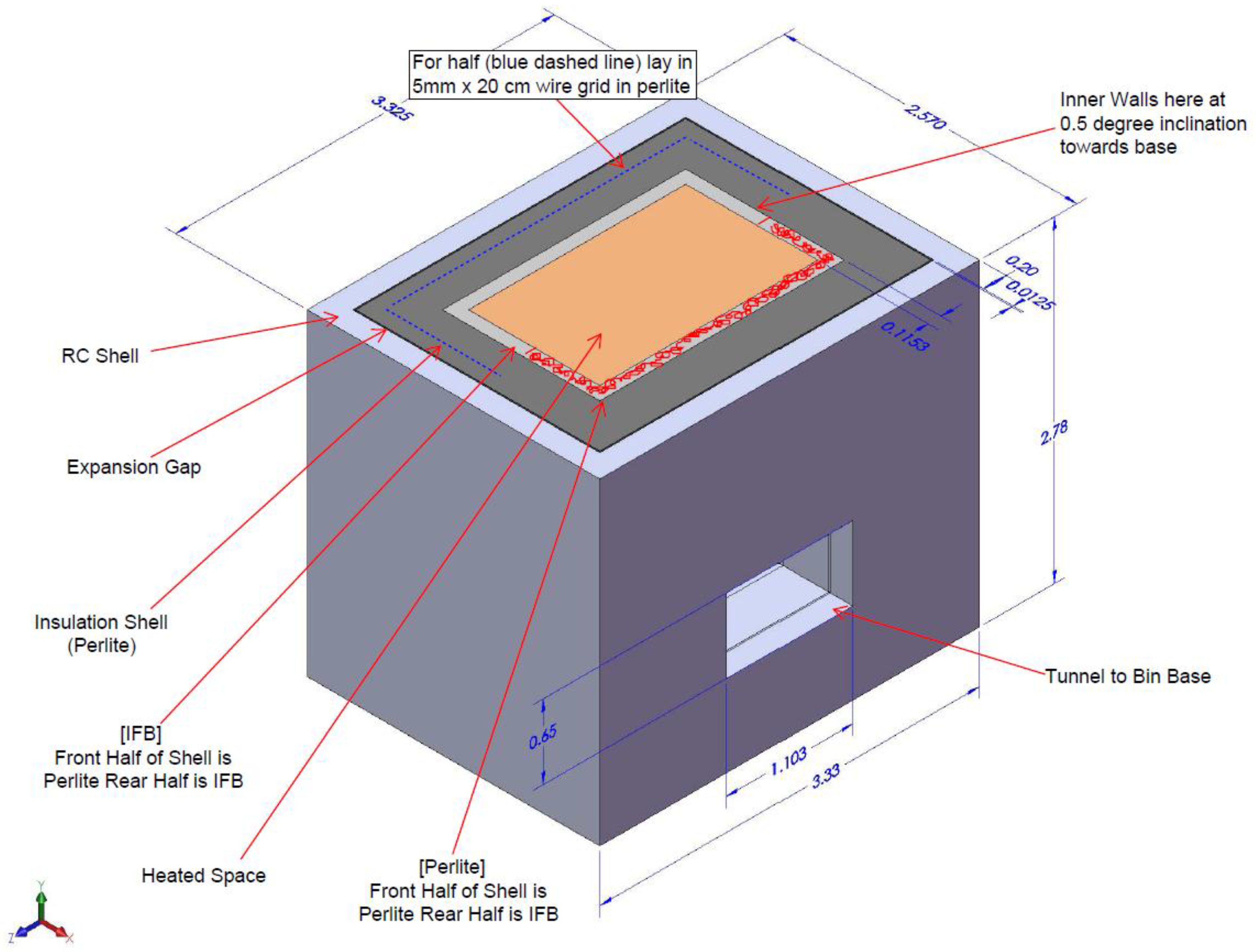
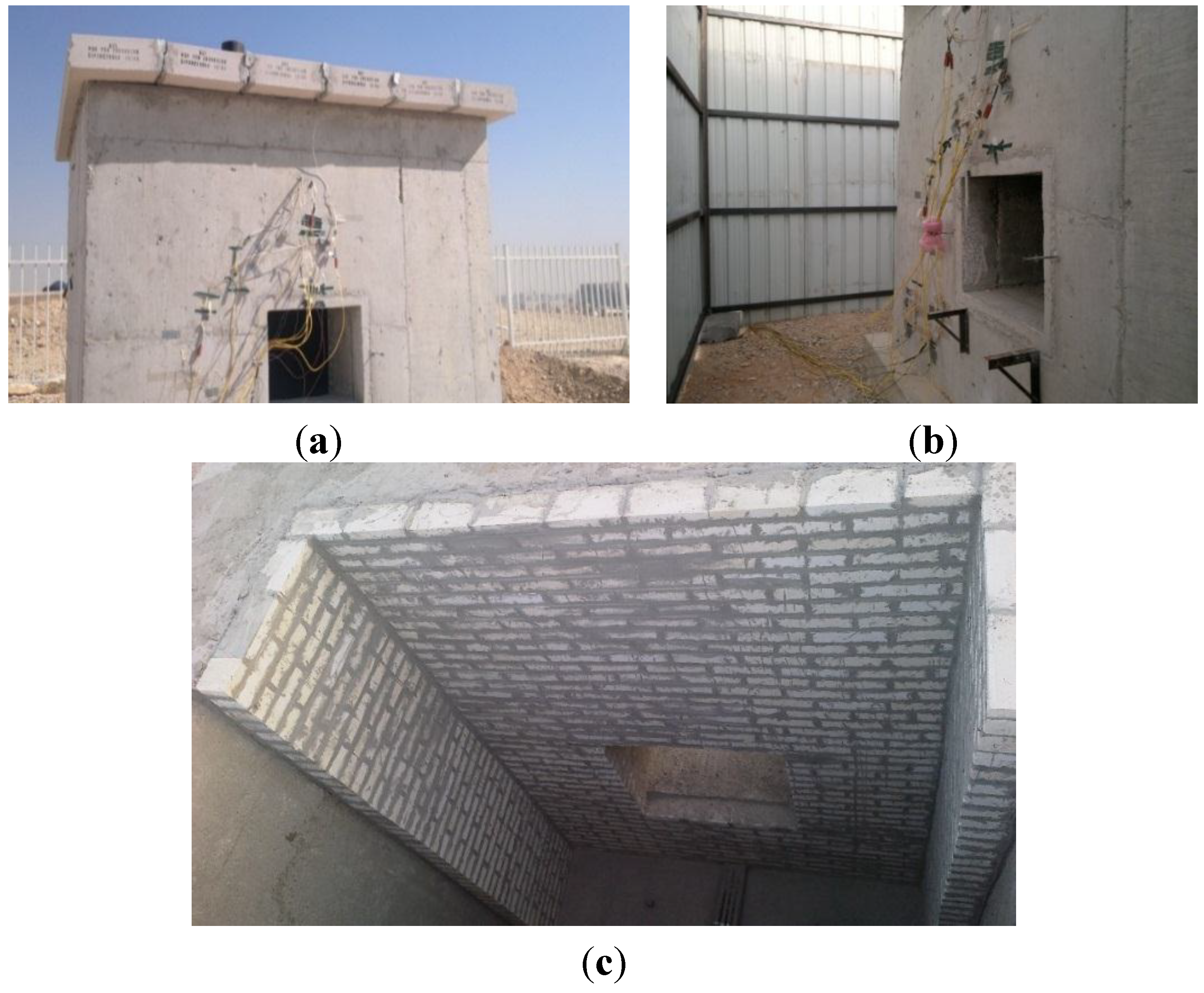
5.2. Results and Discussion
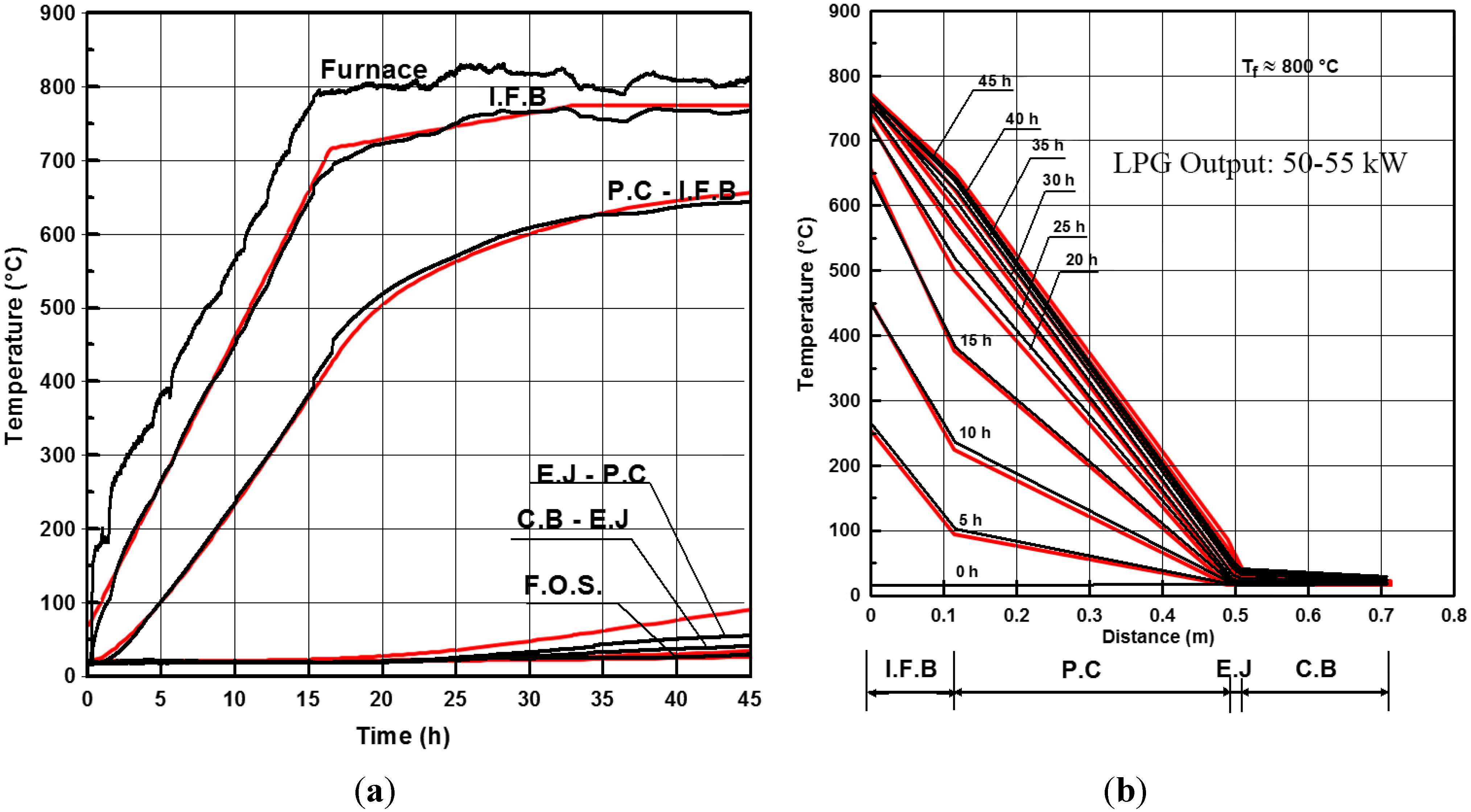
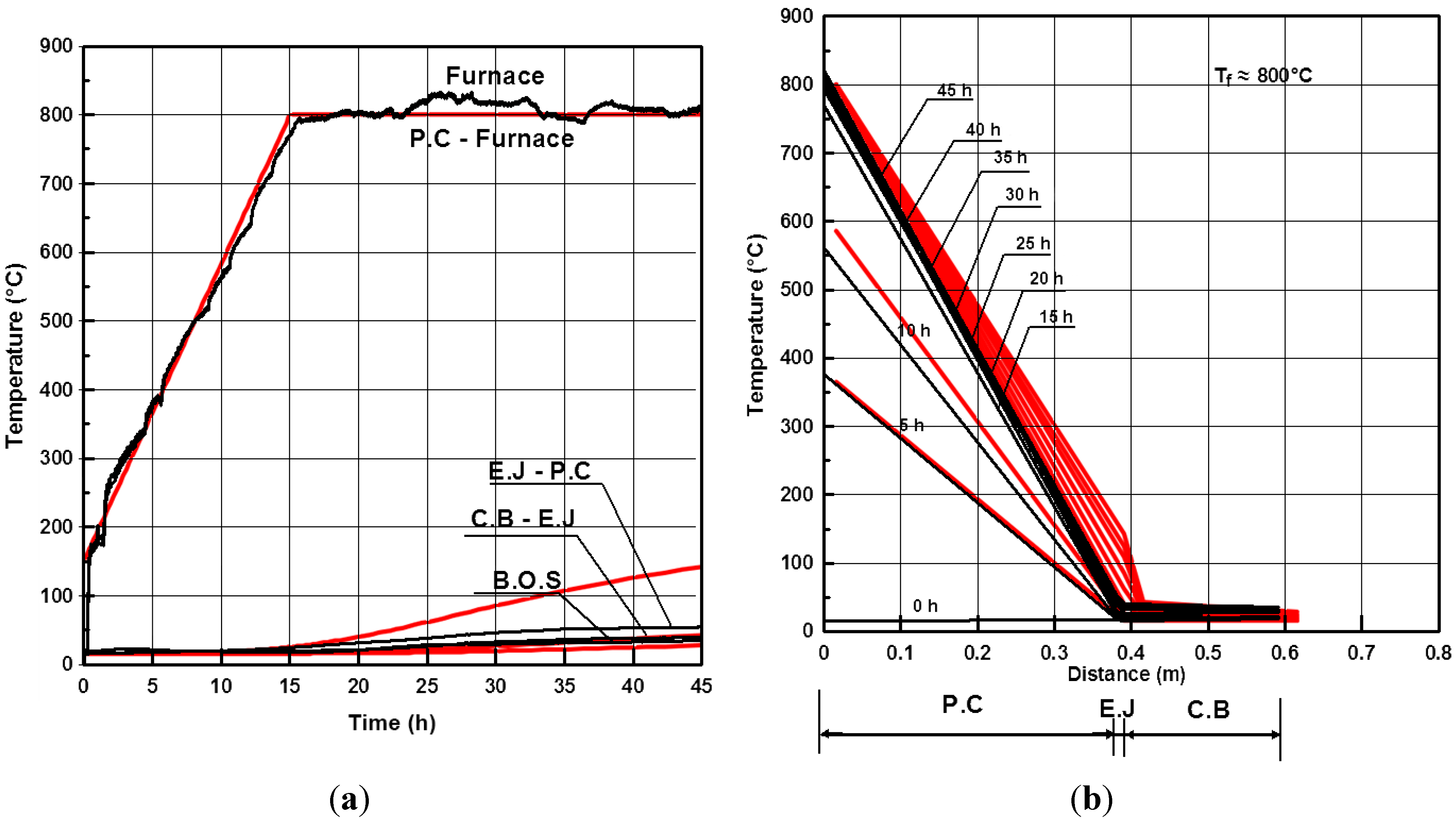
6. Conclusions and Future Recommendations
Acknowledgments
Conflicts of Interest
References
- Martin, J.; Vitko, J. ASCUAS: A Solar Central Receiver Utilizing a Solid Thermal Carrier; SAND-82-8203; Sandia National Laboratories: Livermore, CA, USA, 1982. [Google Scholar]
- Hruby, J.M. A Technical Feasibility Study of a Solid Particle Solar Central Receiver for High Temperature Applications; SAND-86-8211; Sandia National Laboratories: Livermore, CA, USA, 1986. [Google Scholar]
- Falcone, P.K. Technical Review of the Solid Particle Receiver Program; SAND-84-8229; Sandia National Laboratories: Livermore, CA, USA, 1984. [Google Scholar]
- Falcone, P.K.; Noring, J.E.; Hruby, J.M. Assessment of a Solid Particle Receiver for a High Temperature Solar Central Receiver System; SAND-85-8208; Sandia National Laboratories: Livermore, CA, USA, 1985. [Google Scholar]
- Stahl, K.A.; Griffin, J.W.; Matson, B.S.; Pettit, R.B. Optical Characterization of Solidparticle Solar Central Receiver Materials; SAND-85-1215; Sandia National Laboratories: Livermore, CA, USA, 1986. [Google Scholar]
- Stahl, K.A.; Griffin, J.V.; Matson, B.S.; Pettit, R.B. Optical Characterization of Solid Particle Solar Central Receiver Materials; SAND-85-0064; Sandia National Laboratories: Livermore, CA, USA, 1985. [Google Scholar]
- Hruby, J.M.; Burolla, V.P. Solid Particle Receiver Experiments: Velocity Measurements; SAND-84-8238; Sandia National Laboratories: Livermore, CA, USA, 1984. [Google Scholar]
- Hruby, J.M.; Steeper, R.; Evans, G.H.; Crowe, C.T. An Experimental and Numerical Study of Flow and Convective Heat Transfer in a Freely Falling Curtain of Particles; SAND-84-8714; Sandia National Laboratories: Livermore, CA, USA, 1986. [Google Scholar]
- Rightley, M.J.; Matthews, L.K.; Mulholland, G.P. Experimental characterization of the heat transfer in a free-falling-particle receiver. Sol. Energy 1992, 48, 363–374. [Google Scholar] [CrossRef]
- Siegel, N.; Kolb, G.J. Design and on-sun testing of a solid particle receiver prototype. In Proceedings of ASME 2nd International Conference on Energy Sustainability, Jacksonville, FL, USA, 10–14 August 2008.
- Evans, G.; Houf, W.; Grief, R.; Crowe, C. Gas-particle flowwithin a high temperature solar cavity receiver including radiation heat transfer. ASME J. Sol. Energy Eng. 1987, 109, 134–142. [Google Scholar] [CrossRef]
- Evans, G.; Houf, W.; Grief, R.; Crowe, C. Numerical Modeling of a Solid. Particle Solar Central Receiver; SAND-85-8249; Sandia National Laboratories: Livermore, CA, USA, 1985. [Google Scholar]
- Evans, G.; Houf, W.; Grief, R.; Crowe, C. Gas particle flow within a high temperature cavity including the effects of thermal radiation. Heat Transf. Denver 1985, 81, 245–253. [Google Scholar]
- Meier, A. A predictive CFD model for a falling particle receiver/reactor exposed to concentrated sunlight. Chem. Eng. Sci. 1999, 54, 2899–2905. [Google Scholar] [CrossRef]
- Chen, H.; Chen, Y.; Hsieh, H.T.; Siegel, N. Computational fluid dynamics modeling of gas-particle flow within a solid-particle solar receiver. ASME J. Sol. Energy Eng. 2007, 129, 160–170. [Google Scholar] [CrossRef]
- Warerkar, S.; Schmitz, S.; Goettsche, J.; Hoffschmidt, B.; Reißel, M.; Tamme, R. Air-sand heat exchanger for high-temperature storage. In Proceedings of ASME Energy Sustainability Conference, San Francisco, CA, USA, 19–23 July 2009.
- Baumann, T.; Boura, C.; Göttsche, J.; Hoffschmidt, B.; O’Connell, B.; Schmitz, S.; Zunft, S. Air-Sand Heat Exchanger Materials and Flow Properties. In Proceedings of the SolarPACES 2011, Granada, Spain, 20–23 September 2011.
- Kubie, J. Steady-state conduction in stagnant beds of solid particles. Int. J. Heat Mass Transf. 1987, 30, 937–947. [Google Scholar] [CrossRef]
- Li, X.-Y.; Li, L.; Yu, J.-W.; Liu, J.-Q.; Wu, Y.-Y. Investigation of the dynamic characteristics of a storage tank discharging process for use in conventional air-conditioning system. Sol. Energy 2013, 96, 300–310. [Google Scholar] [CrossRef]
- Xu, C.; Li, X.; Wang, Z.; He, Y.; Bai, F. Effects of solid particle properties on the thermal performance of a packed-bed molten-salt thermocline thermal storage system. Appl. Therm. Eng. 2013, 57, 69–80. [Google Scholar] [CrossRef]
- Mario, C.; Giorgio, C.; Pierpaolo, P.; Fabio, S. Numerical investigation of a packed bed thermal energy storage system with different heat transfer fluids. Energy Procedia 2014, 45, 598–607. [Google Scholar] [CrossRef]
- Ho, C.K.; Khalsa, S.S.; Siegel, N.P. Modeling on-sun tests of a prototype solid particle receiver for concentrating solar power processes and storage. In Proceedings of the ASME 2009 3rd International Conference on Energy Sustainability, San Francisco, CA, USA, 19–23 July 2009.
- Al-Ansary, H.; El-Leathy, A.; Al-Suhaibani, Z.; Al-Zahrani, S.; Jeter, S.; Abdel-Khalik, S.; Sadowski, D.; Golob, M. Solid Particle Receiver with Porous Structure for Flow Regulation and Enhancement of Heat Transfer. U.S. Patent 20130068217 A1, 21 March 2013. [Google Scholar]
- Hansen, W.; Livovich, A. Thermal conductivity of refractory insulating concrete. J. Am. Ceram. Soc. 1953, 36, 356–362. [Google Scholar] [CrossRef]
- Ashar, H.; Scott, B.; Artuso, J.F.; Stevenson, J.D. Code for concrete reactor vessels and containments. In Companion Guide to the ASME Boiler and Pressure Vessel, 3rd ed.; American Society of Mechanical Engineers: New York, NY, USA, 2009. [Google Scholar]
- Schneider, U. Verhalten von beton bei hohen temperaturen. In Deutscher Ausschuss fuer Stahlbeton; Wilhelm Ernst & Sohn: Munich, Germany, 1982. (In German) [Google Scholar]
- Petzold, A.; Röhrs, M. Concrete for High Temperature; Maclaren and Sons: London, UK, 1970. [Google Scholar]
© 2014 by the authors; licensee MDPI, Basel, Switzerland. This article is an open access article distributed under the terms and conditions of the Creative Commons Attribution license (http://creativecommons.org/licenses/by/4.0/).
Share and Cite
El-Leathy, A.; Jeter, S.; Al-Ansary, H.; Abdel-Khalik, S.; Roop, J.; Golob, M.; Danish, S.; Alrished, A.; Djajadiwinata, E.; Al-Suhaibani, Z. Thermal Performance Evaluation of Two Thermal Energy Storage Tank Design Concepts for Use with a Solid Particle Receiver-Based Solar Power Tower. Energies 2014, 7, 8201-8216. https://doi.org/10.3390/en7128201
El-Leathy A, Jeter S, Al-Ansary H, Abdel-Khalik S, Roop J, Golob M, Danish S, Alrished A, Djajadiwinata E, Al-Suhaibani Z. Thermal Performance Evaluation of Two Thermal Energy Storage Tank Design Concepts for Use with a Solid Particle Receiver-Based Solar Power Tower. Energies. 2014; 7(12):8201-8216. https://doi.org/10.3390/en7128201
Chicago/Turabian StyleEl-Leathy, Abdelrahman, Sheldon Jeter, Hany Al-Ansary, Said Abdel-Khalik, Jonathan Roop, Matthew Golob, Syed Danish, Abdulaziz Alrished, Eldwin Djajadiwinata, and Zeyad Al-Suhaibani. 2014. "Thermal Performance Evaluation of Two Thermal Energy Storage Tank Design Concepts for Use with a Solid Particle Receiver-Based Solar Power Tower" Energies 7, no. 12: 8201-8216. https://doi.org/10.3390/en7128201





